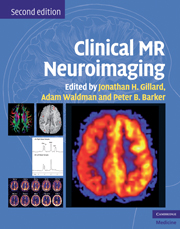Book contents
- Frontmatter
- Contents
- Contributors
- Case studies
- Preface to the second edition
- Preface to the first edition
- Abbreviations
- Introduction
- Section 1 Physiological MR techniques
- Chapter 1 Fundamentals of MR spectroscopy
- Chapter 2 Quantification and analysis in MR spectroscopy
- Chapter 3 Artifacts and pitfalls in MR spectroscopy
- Chapter 4 Fundamentals of diffusion MR imaging
- Chapter 5 Human white matter anatomical information revealed by diffusion tensor imaging and fiber tracking
- Chapter 6 Artifacts and pitfalls in diffusion MR imaging
- Chapter 7 Cerebral perfusion imaging by exogenous contrast agents
- Chapter 8 Detection of regional blood flow using arterial spin labeling
- Chapter 9 Imaging perfusion and blood–brain barrier permeability using T1-weighted dynamic contrast-enhanced MR imaging
- Chapter 10 Susceptibility-weighted imaging
- Chapter 11 Artifacts and pitfalls in perfusion MR imaging
- Chapter 12 Methodologies, practicalities and pitfalls in functional MR imaging
- Section 2 Cerebrovascular disease
- Section 3 Adult neoplasia
- Section 4 Infection, inflammation and demyelination
- Section 5 Seizure disorders
- Section 6 Psychiatric and neurodegenerative diseases
- Section 7 Trauma
- Section 8 Pediatrics
- Section 9 The spine
- Index
- References
Chapter 11 - Artifacts and pitfalls in perfusion MR imaging
from Section 1 - Physiological MR techniques
Published online by Cambridge University Press: 05 March 2013
- Frontmatter
- Contents
- Contributors
- Case studies
- Preface to the second edition
- Preface to the first edition
- Abbreviations
- Introduction
- Section 1 Physiological MR techniques
- Chapter 1 Fundamentals of MR spectroscopy
- Chapter 2 Quantification and analysis in MR spectroscopy
- Chapter 3 Artifacts and pitfalls in MR spectroscopy
- Chapter 4 Fundamentals of diffusion MR imaging
- Chapter 5 Human white matter anatomical information revealed by diffusion tensor imaging and fiber tracking
- Chapter 6 Artifacts and pitfalls in diffusion MR imaging
- Chapter 7 Cerebral perfusion imaging by exogenous contrast agents
- Chapter 8 Detection of regional blood flow using arterial spin labeling
- Chapter 9 Imaging perfusion and blood–brain barrier permeability using T1-weighted dynamic contrast-enhanced MR imaging
- Chapter 10 Susceptibility-weighted imaging
- Chapter 11 Artifacts and pitfalls in perfusion MR imaging
- Chapter 12 Methodologies, practicalities and pitfalls in functional MR imaging
- Section 2 Cerebrovascular disease
- Section 3 Adult neoplasia
- Section 4 Infection, inflammation and demyelination
- Section 5 Seizure disorders
- Section 6 Psychiatric and neurodegenerative diseases
- Section 7 Trauma
- Section 8 Pediatrics
- Section 9 The spine
- Index
- References
Summary
Introduction
As described in Chs. 7 and 8, MRI provides two alternative approaches to measure perfusion: using a bolus of an exogenous paramagnetic contrast agent (dynamic susceptibility contrast MRI [DSC-MRI]; see Ch. 7 for details) or by means of magnetically labeled blood as an endogenous tracer (arterial spin labeling [ASL]; see Ch. 8 for details). Both techniques have been extensively used since the early 1990s, and important improvements have made them more accurate and robust. However, some significant issues must be considered whenever implementing, using, and (especially) interpreting the images generated by either technique. This is because both methods rely on certain assumptions that cannot always be satisfied, and they can be prone to artifacts. This chapter discusses the most important caveats relating to absolute quantification of perfusion MRI, with particular emphasis on the potential implications for absolute cerebral blood flow (CBF) measurements in clinical use.
Artifacts and limitations
Dynamic susceptibility contrast MRI
Although DSC-MRI can provide, in principle, absolute measurements of CBF, cerebral blood volume (CBV), and mean transit time (MTT), there are a number of issues that can affect the accuracy of these measurements. The most common potential sources of error are described below.
Information
- Type
- Chapter
- Information
- Clinical MR NeuroimagingPhysiological and Functional Techniques, pp. 137 - 155Publisher: Cambridge University PressPrint publication year: 2009
References
Accessibility standard: Unknown
- 2
- Cited by
